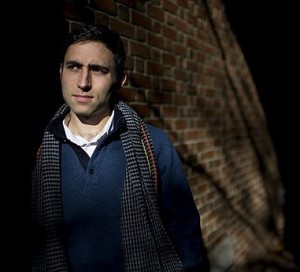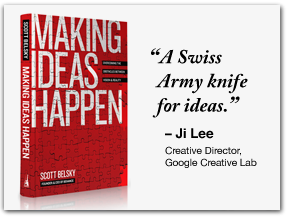Today I will be interviewing Scott Belsky, Scott and I had the opportunity to meet about four years ago when I was introduced to the Action Method. I liked it so much now all my clients use it and CO2 Partners sells it on our website. When I learned that Scott had a new book out, Making Ideas Happen, I wanted to have him interviewed for our blog readers. A little about Scott before we jump into the interview.
Scott Belsky believes that the greatest breakthroughs across all industries are a result of creative people and teams that are especially productive. As such, Scott has committed his professional life to help organize creative individuals, teams, and networks.
Scott is the founder and CEO of Behance, a company that develops products and services for creative industries. Behance oversees the Behance Network, the world’s leading online platform for creative professionals; The 99%, Behance’s think tank and annual conference devoted to execution in the creative world, and Action Method, a popular online/mobile productivity application and line of organizational paper products.
Scott is also the author of Making Ideas Happen (Portfolio Imprint, Penguin Books, April, 2010).
Behance’s first product, the Behance Network, has become the leading online platform for creative professionals. The Network receives over 4 million visitors every month and has become one of the most efficient platforms for creative professionals to broadcast their work to top agencies, fans, peers, and recruiters.
In 2008, Behance launched Action Method, a revolutionary “action management” system that has replaced traditional project management practices throughout the creative professional world and beyond. Behance also developed the Action Method product line – a series of organizational products that are sold around the world and in Behance’s online store.
Through his work at Behance, Scott has become an advocate for technology and community initiatives that empower the careers of creative professionals and the growth of small and rapidly-changing businesses. He has consulted for leading media and Fortune 500 companies, including GE and Hewlett-Packard, and has traveled as far as the Kaospilots School in Aarhus, Denmark to talk about his findings. He has appeared in the Wall Street Journal and BusinessWeek, and has shared Behance’s research in segments on ABC News, MSNBC (1) (2), and with the United States State Department. Scott has also guest lectured at Cornell University, Harvard University, VCU Brand Center, and UC Berkeley among other institutions, and serves as a small business expert on American Express’ Open Forum website.
Prior to founding Behance, Scott helped grow the Pine Street Leadership Development Initiative at Goldman, Sachs & Co. Scott was especially focused on organizational improvement and strengthening relationships with Goldman Sachs’ key clients. Scott chairs the Board of Reboot, serves on the Advisory Board of Cornell University’s Entrepreneurship Program, is a board member for the Art Director’s Club, and is a member of the International Academy of Digital Arts and Sciences. He attended Cornell University as an undergraduate and received his MBA from Harvard Business School.
The Interview:
What was the question you have been wanting to answer with your new book, Making Ideas Happen, your beautiful Action Method stationary line, and your totally cool Action Method online software with iPhone capabilities?
The question my team wants to help people answer is simple: How do I get organized and make my ideas happen? For almost four years, we’ve been on a bold mission to help organize creative people and teams. The book – along with our other products and services – were all created with the same mission in mind.
What is the connection between your book Making Ideas Happen and the Action Method Products?
For over five years I have been studying (borderline obsessed) with execution and organization in the creative world – and among entrepreneurs. Along the way, I have been interviewing especially productive leaders. My first question is always, “How do you stay organized?
The “Action Method” is a methodology that encompasses many of the best practices I have observed over the years. While our team also developed an online/offline suite of products based on the methodology, I think the methodology works with ANY tools on the market. The Action Method is a mindset of project management with a bias towards action (hence the name!).
My book, MAKING IDEAS HAPPEN, was the outcome of the years of interviews and research around productive and sound leadership in the creative world. The book explores the Action Method as well as other methods, insights, and best practices used by leading creative people and teams across industries – companies like Google, IDEO, and Disney, and individuals like author Chris Anderson and Zappo’s CEO Tony Hsieh.
What does Making Ideas Happen have to do with the creative process?
Well, “process” is such a dirty word. It is thrown around quite a bit. And while many practitioners prescribe one particular process as being the best approach to creative project, I disagree. Process needs to be organically derived – often by trial and error – by individuals and teams. Why? Because a great process commands loyalty. Only by customizing “creative process” can we remain attracted (and loyal) over time.
Only a personally-derived process will keep us engaged long enough to push bold ideas to fruition. We need to make process “sticky.” The problem with creative minds in large corporations is that bureaucratic tools don’t take personalization into account. As a result, we are stuck using bulky tools that repel us. No wonder creatives have a bad reputation when it comes to adhering with process! Given the unique characteristics of the optimal workflow for creative people and teams, we face a unique set of challenges. I’m very interested in understanding these differences and how to reconcile them. The book is essentially an A LA CARTE approach to creative process. Starting with project management and ending with leading a team in creative pursuits.
You come from a background that is a bit unexpected for the creative and time management business. Can you share with us what is your background and how you got started in this business?
I studied some information design in college, but was focused on business. During my tenure at Goldman Sachs, I was always itching to return to the world of design and creative industries. While at Goldman Sachs, I worked on a special team in the Executive Office that focused on organizational improvement and leadership development. When I left Goldman Sachs, I was determined to leverage the knowledge and ideas I had developed at Goldman Sachs in the creative world.
I attended Harvard Business School and had the opportunity to work with Professor Teresa Amabile, the famed expert on creativity in business. While getting my MBA, I founded Behance with a few other like-minded folks. Finally, looking back at it all…it makes sense. But it was quite a roller-coaster along the way!
Many people are familiar with Franklin Covey, Daytimer and the like. How is your method different, and more relevant in todays high paced work environment?
The Action Method is PROJECT centric rather than CONTEXT centric. In the era upon us, work, home, and the transit time in between all blends… Actionable items in our personal projects and “work” projects also blend. As such, life’s projects should be broken down into tasks. We should live life with a bias towards action – focusing less on “reference material.” We should content-make rather than commentate. And we should use DESIGN to make us more productive. The Action Method encourages us to “advertise action” to ourselves and, for the purpose of taking action on our ideas, use the same tricks that Madison Avenue marketing agencies use to make us buy stuff.
Who did you write the book for?
I wrote the book for people with lots of ideas and a dose of frustration with the process of actually making them happen. As we all know, most ideas never happen – whether for new businesses or solutions to problems we face in our lives. The odds are not in our favor.
Scott Belsky: Don’t Let Your Genius Go Unnoticed from 99% on Vimeo.
I hope the book prompts more discussion about organization and execution in the creative world. I think there is too much emphasis on inspiration and the sources of creativity – the romantic pursuit of ideas – rather than what comes AFTER the idea. This book is all about the execution, and I hope it serves as a powerful catalyst for more introspection and discussion. I also hope that readers leave with at least 3-5 things that they will do differently in their creative projects. The book is full of practical tips that I’ve observed across industries. And while nobody will adopt ALL of them, I do think that a few critical tweaks can make all the difference.
What is reactionary work flow and how does Making Ideas Happen address it?
Without realizing it, most of us have started to live a life of “reactionary workflow.” We are constantly bombarded with incoming communications – email, text, twitter, facebook, phone calls, instant messenger, etc… Rather than be proactive with our energy, we are spending all of our energy being reactive and living at the mercy of the last incoming thing.
MAKING IDEAS HAPPEN highlights some of the tips that especially productive leaders employ to overcome reactionary workflow. For example, some of the most productive people I have met schedule “windows of non-stimulation” in their day. For a 2-3 hour period of time, these people minimize their email and all other source of incoming communication. With this time, they focus on a list of long-term items – not their regular tasks, but long-term projects that require research and deep thought.
I know you strongly believe in the collaborative approach – how did you use this approach in writing this book?
I received tremendous amounts of feedback from my colleagues – and members of the Behance Network – over the course of writing the book. Our company’s think tank, The 99% (the99percent.com), also proved an invaluable source of accountability and ideas for the book.
What are the steps for someone to break through a project plateau should consider to be more effective?
The “project plateau” is the zone of projects where most great ideas die. As we all know, ideas are sexy and fun until they become projects. As soon as you commit yourself to pursue an idea, it becomes a project. As you start down the path of execution, you will enter the project’s plateau.
The project plateau is like an expansive desert, void of any oasis of inspiration or excitement. It is the pure drudgery in the middle stages of a project; ceaseless follow-ups and a lot of hard work with no clear end in sight.
It is no surprise that most bold ideas-turned-projects are abandoned in the project plateau. As we trudge our way through, we get easily distracted by life’s demands. As creative minds, we also come up with new ideas which entice us to escape the doldrums of the project plateau and start all over again with something new and shiny. The project plateau is especially difficult to endure without the usual short-term rewards that keep us motivated. The usual financial reward and fanfare won’t be there for you mid project. If you’re starting a business, you won’t have any clients or customers yet. If you’re writing a book, you may not even have a publisher yet.
As for BREAKING THROUGH the project plateau, I talk a lot about this in the book. It requires a new approach to projects and tweaking how you manage your energy. It also involves short-circuiting the ingrained reward system that governs your motivation and focus.
You know my clients and I are hooked on the Action Method – in many ways it is like feeding addicts. Once I introduce them to the process and the product line they always show up at our meetings with their offline version of the product and are continually wanting more. Can you share some of the interesting ways people have begun to use your products that were never intended?
Ha! There are many unintended users. One of my favorites is a major movie casting director that uses the Action Steps area of the product to capture the concerns or issues that actors need to address in order to pass to the next level. During the auditions, the Director checks the boxes (or not). If you don’t have your boxes checked, you’re not in the movie. I have also come across people that use different color sheets for different projects – or to separate personal projects from professional projects. Many creative users and thus uses!
For those not using the Action Method what is the best way to learn more and get started?
Well, let me briefly introduce the methodology itself:
The Action Method suggests that every project in life can ultimately be reduced to just 3 primary elements: Action Steps, Backburner Items, and References. Action Steps are succinct tasks that start with verbs. They should be kept separate from your notes and sketches. Backburner Items are ideas that come up during a brainstorm or on the run that are not actionable but may someday be. Backburner Items should be collected in a central location and should be revisit periodically through some sort of ritual. One leader I met prints out his list of Backburner Items (kept on a running Word document) on the first Sunday of every month. He grabs the list (and a beer) and then sits down and reviews the entire list. Some items get crossed out as irrelevant, some remain on the list, and some are transformed into Action Steps. The third element of every project is References – the articles, notes, and other stuff that collects around you. It turns out that References are overrated. Rather than spend tons of time organizing your notes, consider keeping a chronological file where all your notes are simply filed chronologically (not by project name or other means). In the age of digital calendars, you can search for any meeting and quickly find the notes taken on that date.
If users are interested, they can visit ACTIONMETHOD.COM for more details.
Thanks so much for the interview!





